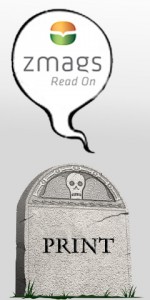
It’s obvious that print is on the decline – falling short on cost effectiveness, reach, and overall practicality of digital media forms.
By utilizing Internet sources, readers can instantly and ubiquitously find all the content that would otherwise be stuck on the pages of some newsstand’s magazine rack. Reading is faster and easier online, but that doesn’t mean that people don’t like the experience of print materials. There is something satisfying about thumbing through the pages of a glossy magazine – an interaction which I believe to be the reason many printed publications are still hanging on.
There’s no doubt that print media will slowly be phased out by the accessibility and convenience of digital online media, even if people are reluctant to abandon the experience of bound pages. However, Zmags, headquartered in Boston, may have the technology for the experience of printed content to live on in the form of interactive digital magazines.
Zmags basically turns PDF files into interactive Flash-based mediums that mimic the experience of a glossy print magazine. I was unable to speak directly with someone from Zmags, but from their website content I gather that they’re actually more focused on company collateral than the publication industry. For example, they gain more revenue by boosting customer interaction through enriching a brochure than actually turn a current print magazine into an online Flash version. A lot of the value is also in detailed analytics for a company’s marketing team.
That being said, they do have some publications as clients and their software certainly has the power to convert print magazines (provided the content is laid out in a PDF) to a digital format.
The most intriguing thing about Zmags and similar technologies is that they introduce the opportunity to infuse magazines with even more rich media. Within Zmags pages you have the option of embedding videos and other media forms that could never be found in print — although the Zmag still lays out in traditional print columns.
With features like video and mouse-over Flash effects, I can’t help but imagine a magazine like National Geographic (one of my favorites) on such an interactive and dynamic platform. Imagine reading an article about the African Savanna while footage of herding African Elephants plays in the place of a static image. Even a simple interactive photo-carousel could deliver an aesthetic value that has yet to be seen on most blogs and other online publications. (Of course, we host that kind of content here, but it’s far from standard.)
Don’t misunderstand me in thinking that Zmags is the first to present the idea of the digital magazine. Many websites have presented the concept of the online catalog or other media that mimics print material on a digital interface. In fact, New York-based Flyp Media already provides an interactive online magazine, and sites like Zinio sell online versions of major print magazines.
The Zmags technology is novel because it gives any user a relatively easy way to transform print materials into the digital form. Even today a lot of magazines have gone to work scanning their archived material to PDF form for easier web access. Why not plug that PDF into a system like Zmags and retain all the joys of tactile print online?
Granted you can’t actually touch the pages, and a pointer is acting the part of your finger, but with touch screen technology on the rise, the digital magazine is perfect for use with products like the new Apple iPad. You’ll notice the iPad iBooks app retains the experience of a bound book, and this is for a reason: people like turning pages!
Who knows, maybe emulated pages are just a transfer period. Maybe as more and more readers are born into the digital age we will lose the need to be reminded of our page-turning days and even digital representations of books will disappear. Until then, people will still want to pretend they’re reading a book, and technologies like Zmags give publications a way to provide that.
